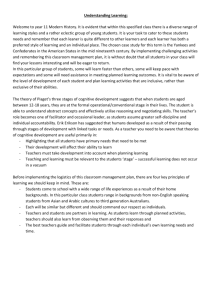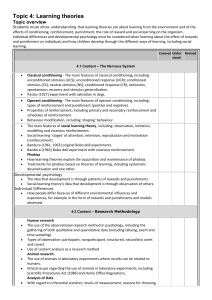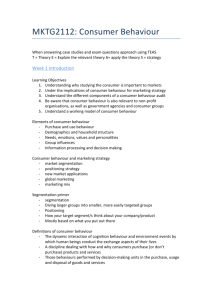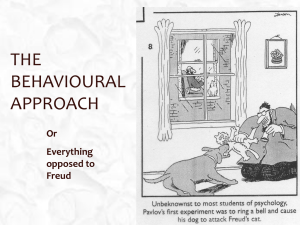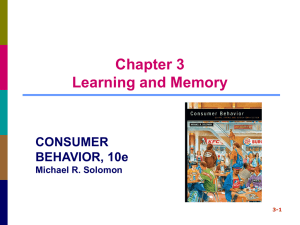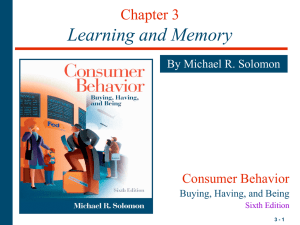Don't stop now
advertisement
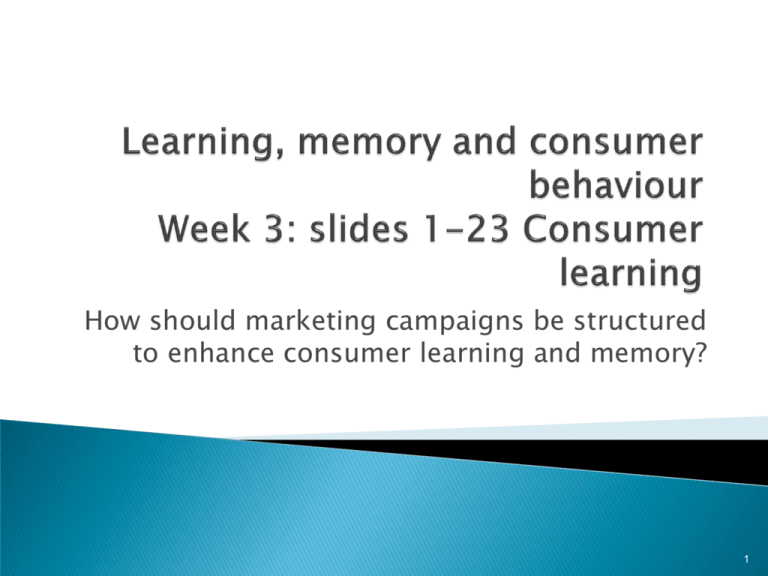
How should marketing campaigns be structured to enhance consumer learning and memory? 1 What we know, think and feel about brands comes from the process of learning What we think and feel are precursors to purchase and consumption So, how does learning take place? What can marketers do to promote positive learning about brands? 2 Motivation – the arousal function that energises behaviour necessary to engage in learning Stimuli – compete for attention and provide direction to motivated activity Response – mental or physical reaction to a stimulus situation Reinforcement – anything that follows a response and increases the likelihood of the response being repeated in a similar situation 3 “a relatively permanent change in behaviour due to past experience” (Coon, 1983) “the process by which relatively permanent changes occur in behavioural potential as a result of experience”(Anderson, 1995) Anderson’s definition recognises importance of potential as distinct from performance ie all the behaviours of which we are capable but not performing at the moment 4 How does information get from the external communication environment into long-term memory where it is used in consumer decision making? What’s the role of the promotional elements of the marketing mix in this process? 5 Knowledge of learning principles can help us to understand how consumer behaviour develops and how to influence it How consumers develop habitual purchase patterns for things and strong loyalty to brands Various theories have been developed to explain different aspects of learning Understanding consumer learning may help us shape consumer behaviour 6 Learning theories Stimulus response Cognitive Classical conditioning Instrumental conditioning Learning involves development of SR connections With varying importance of reinforcement Rote learning Vicarious learning Problem solving Insight 7 8 9 BEFORE CONDITIONING Bike alone - No arousal Sexy girl generates physiological arousal DURING CONDITIONING AFTER CONDITIONING Bike and girl together generates Physiological arousal Bike alone generates physiological arousal 10 Happy situation (US) family gathering Xmas General emotional response Relaxation, nostalgia, excitement (UR) (CR) Brand (CS) Conditioned response is general emotional response in presence of brand which may facilitate brand purchase 11 If the brand and it’s packaging are the conditioned stimulus for the conditioned response (ie evoke the general emotional response) Will changing the stimulus drastically lead to extinction of the CR ? 12 The process of altering the probability of a behaviour by changing the consequences of a behaviour Events or consequences increase the likelihood of a given behaviour being repeated Reward increases the probability of behaviour being repeated = positive reinforcement Performance of behaviour removes aversive stimuli = negative reinforcement 13 A desired behaviour to a conditioned stimulus is rewarded by a positive reinforcer Over a number of reinforced trials a connection between stimulus and response is learned such that the learned behaviour is repeated in the presence of the stimulus Unlike classical conditioning the learner has to discover which response produces the reward – the response is dependent on the learners actions 14 Continuous reinforcement schedule: reward every occurrence of the desired behaviour Fixed ratio reinforcement schedule: reward every nth occurrence (eg every 4th) Variable ratio: reward based on an average 4th occurrence (eg 3rd and 5th, 1st and 7th) 15 Favourable product/service experience strengthens the SR link increasing the likelihood of repeat behaviour The building blocks of sales promotion techniques are built around the principles of instrumental conditioning Partial reinforcement schedules have implications for sales promotion, brand orientation and attitude change 16 Rewarding customers with frequent flyer miles is an effective way to reinforce their behaviour and build brand loyalty Solomon 2006 17 Continuous reinforcement produces rapid learning whilst partial reinforcement produces slower learning that is longer lasting Implications for rewarding loyalty? Couponing frequency Attitude change 18 Before Clubcard Tesco was stuck as the UK’s second ranking supermarket Today Tesco is by far the UK’s largest grocer (>30% market share) Tesco.com is the world’s largest grocery etailer UK’s largest employer Europe’s fastest growing financial services company 19 “Contrary to popular belief, Tesco’s most significant competitive advantage in the UK is not it’s scale. We believe Clubcard, which conveys an array of material benefits across virtually every discipline of it’s business, is Tesco’s most potent weapon in the ongoing battle for market share. Tesco is big because it is good, not vice versa.” JP Morgan Cazenove 20 Reward the behaviour you seek (increase frequency of visits, shop new departments, trial new lines, use new services) Desired behaviours can be developed and maintained with small and infrequent rewards) Establish priorities and measures for the behaviour changes you want to see You can’t achieve every behaviour change at once 21 Each quarterly mailing gives customers the cash value of their points plus coupons based on how Tesco seeks to shape their behaviour TOTAL SALES UPLIFT 60% 40% Money-off coupons to reinforce existing behaviours and encourage new trials based on known profiles Customers redeeming vouchers in areas where Tesco encouraged them to shop and increasing spend for that visit 22 Learning is a behavioural change arising from experience In classical conditioning a learned association elicits a naturally occurring response. Positive associations with products/brands are created through such stimulus pairings. In instrumental conditioning behaviour is shaped by rewarding the desired response Marketers must create positive associations with their brands and build recognition and recall 23 Learning Motivation Stimulus Responce Reinforcement UCS UCR CS CR Classical conditioning Instrumental conditioning Reinforcement schedule 24 Retrieval: Information is recovered from memory when needed 25 Memory processes are important because consumers act on the basis of cognitions which are stored in memory and influence how incoming stimuli are interpreted The challenge for marketers is to have consumers remember your name and brand in preference to those of competitors The fastest rate of forgetting occurs soon after learning has occurred – how do advertisers counter that? 26 Temporary storage of sensory information – less then 1 second Information Sensory memory Brief storage of information currently being used. Limited Capacity. Less then 20 seconds Maintenance Rehearsal loop Short term memory Long term memory Elaborative rehearsal Forgotten material Long term/ Permanent. Unlimited capacity 27 Sensory memory stores after images which are lost quickly through decay unless capturing sufficient attention and further processing Short term memory temporarily stores and processes information to comprehend meaning – it is limited by both time and space. Information not rehearsed is lost through decay Long term memory is the long term store for information which is coded in a variety of different ways 28 Semantic encoding – an object is not directly represented in memory but rather in terms of its meaning for the individual (networks of knowledge eg Nike shoes = cushioned, Swoosh, lightweight) Scripts – represent series of actions based on previous events which influence future actions when a similar situation occurs (enter store, go straight ahead to fruit and veg, turn left to milk) Visual encoding – using mental images to store information often leads to strong long term memory for material (eg Wonderbra, Calvin Klein, Benetton) 29 Messages with unique aspects are more likely to be remembered (Guinness) The beginning and end of messages are more likely to be remembered (“Washes whiter” at beginning and end) Messages that encourage immediate rehearsal of material stimulate it’s retention (jingles – “that’s ASDA price”) If material lends itself to “chunking” more information can be processed and retained (“New action ball tabs from Vanish – 1 chunk – Give power of whitening in your wash – 1 chunk – So stains vanish – 1 chunk.) 30 Memory is cue dependent (characteristics of the learning situation)and presentation of relevant cues will stimulate recall Material that is meaningful to the individual is learned more quickly and more likely to be remembered Visual content is frequently more memorable than verbal content 31 Meaningful and relevant Content is largely visual Cue dependency 32 The pink bunny from the TV commercial is added to the packaging to aid brand recall at point of purchase Solomon 2006 Illustrates cue dependency – the stimulus was present in the learning environment 33 Familiarity with an iconic symbol enhances brand recall. Jolly Green Giant has appeared in ads and packaging for 30 years...yo ho ho! Important in creating and Solomon 2006 awareness maintaining 34 The “mere exposure effect”: customers prefer similarity 35 Learned information is stored in memory Retrieval is the process whereby stored information is accessed A variety of factors influence likelihood of recall including mood, familiarity, salience and format (pictorial vs verbal) Memory for product information can be measured through recognition or recall techniques 36
